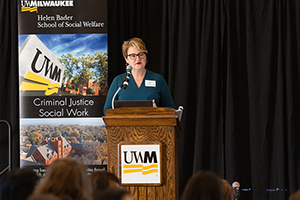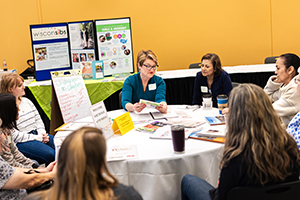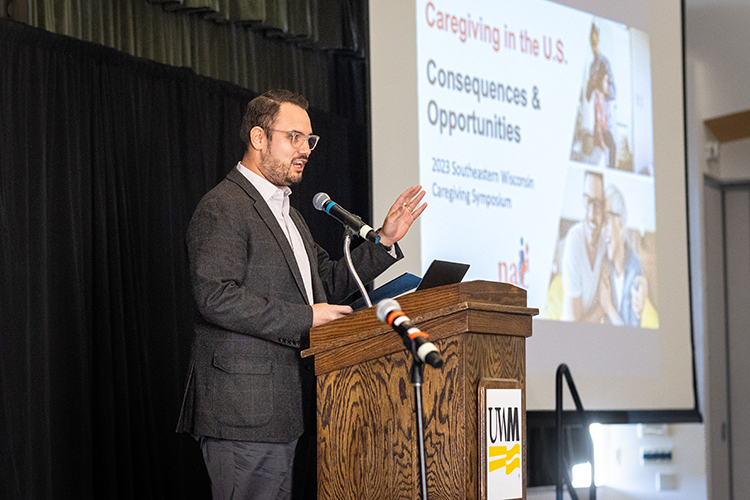More than 53 million people in the U.S. are taking care of aging family members, a number that ballooned by 10 million between 2014 and 2020, according to Caregiving in the U.S., the National Alliance of Caregiving’s ongoing data project with AARP.
“We see that caregiving is becoming more prevalent, more complex and more intense over time, which has financial and economic consequences for family caregivers,” said Jason Resendez, president and CEO of the National Alliance of Caregiving.
Resendez was the keynote speaker at the Southeastern Wisconsin Symposium on Caregiving, the first of its kind in the region. The symposium, held at UWM in early October, was co-sponsored by UWM’s Helen Bader School of Social Welfare and Advancing a Healthier Wisconsin Endowment at the Medical College of Wisconsin. The alliance focuses on studying caregiving needs and advocating for improved public policies to support families who are taking care of loved ones.

Caregiving is an issue that eventually affects nearly everyone, Resendez said. It’s reflected in a favorite quote of his from former first lady Rosalynn Carter: “I like to say that there are only four kinds of people in the world – those who have been caregivers, those who are currently caregivers, those who will be caregivers and those who will need caregivers.”
In an interview prior to the symposium, Resendez outlined some of the key issues facing caregivers.
While caregiving impacts everyone, it doesn’t affect everyone equally, he said. “From the data, we know that caregivers of color, particularly Black and Latina caregivers, are more likely to experience negative health and financial impacts.” Many of these women – and caregivers are primarily women – are in low wage jobs that are less likely to offer supportive benefits like paid family and medical leave, Resendez said.
Several factors are driving the increases in the numbers of family caregivers, he said.
Aging: The aging of baby boomers and their parents is creating more of a need for family caregivers. “The graying of the population is one of the things we see not just in the future, but over the last two decades, contributing to more and more people taking on the caregiving role.”
Fewer workers: At the same time, fewer and fewer people are entering the direct care workforce, so more responsibility is falling on unpaid family caregivers.
Aging in place: In addition, an increasing number of older people are choosing to age in their own homes, placing additional demand on family caregivers.
Shifting care out of hospitals: Policy changes in health care systems are shifting more care from hospitals and acute care settings to homes, saving money for the hospital systems but putting more stress on family caregivers.
“We know that 58% of family caregivers are providing highly specialized medical care,” Resendez said, assisting with medical and nursing tasks like changing feeding tubes that would traditionally be done by a trained professional.

A key focus of Resendez presentation was looking at the policy changes needed to support these unpaid family caregivers at the state and national level.
“The U.S. is one of the industrial countries without a national paid leave policy,” he said, “but we are seeing more and more states introducing paid medical and family leave.” According to the organization’s data, more caregivers had access to family leave in 2020 than in 2015.
When the National Alliance of Caregiving asked caregivers about the changes they’d like to see, a key request was recognition of the financial value of what they do. “While it’s unpaid work, that doesn’t mean it doesn’t have value,” Resendez said.
AARP has valued unpaid family caregiving at around $600 billion annually, he added.
Specific suggestions from caregivers included policies that help offset the costs of the work they do, like tax credits for the money they spend taking care of family members. Family caregivers spend an average of $7,000 a year in out-of-pocket costs for supplies and changes to housing to accommodate older family members, according to the national organization.
The family caregivers also support Social Security credits to recognize the needs of those – particularly women – who need leave the workforce to care for family members, affecting their eventual Social Security benefits.
Payments to family caregivers
Another key policy change the organization and caregivers support is payments to family caregivers for their work. Several states, particularly during the pandemic, started paying family caregivers using Medicaid waivers in response to a shortage of direct care workers. “That hasn’t been uniform across the country. We’re still figuring out how to create these programs and make them sustainable,” Resendez said.
One positive change is the development of a national strategy to support family caregivers, which was released at the end of 2022, Resendez said. “We now have for the first time ever a whole-of-society blueprint for how to better support family caregivers.”
The Oct. 9 symposium at UWM featured an interactive panel discussion with local experts who shared their successes and challenges, focusing on diverse caregiving populations including children/youth, university students, LGBTQ, Latino and African American. Several caregiving support organizations had resource tables.
“We offered opportunities for professionals to learn what other caregiving programs exist, what other organizations may or may not be doing, and facilitating the opportunities for professionals to learn from each other,” said Melinda Kavanaugh, UWM professor of social work, who co-led the symposium as part of a consortium of health care, community and county organizations focused on caregiving in the region.







